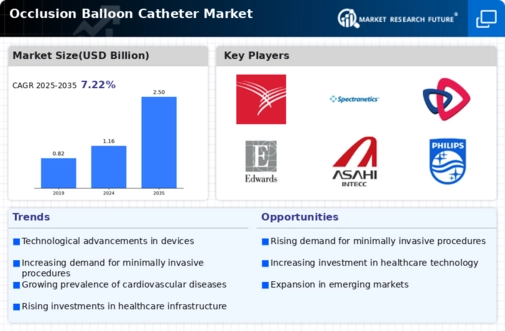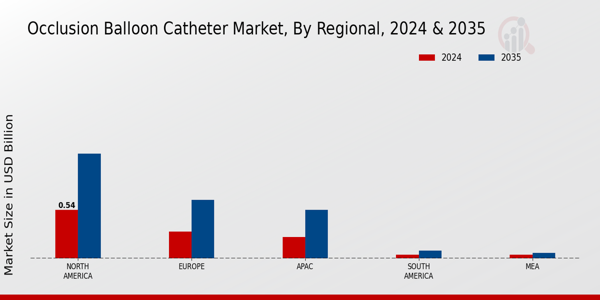Market Growth Projections
The Global Occlusion Balloon Catheter Market Industry is projected to experience substantial growth in the coming years. With an estimated market value of 1.16 USD Billion in 2024, the industry is expected to reach 2.5 USD Billion by 2035. This growth trajectory reflects a compound annual growth rate (CAGR) of 7.23% from 2025 to 2035, indicating a robust demand for occlusion balloon catheters across various medical applications. The increasing prevalence of cardiovascular diseases, technological advancements, and the rising geriatric population are key factors driving this expansion, positioning the industry for a promising future.
Growing Geriatric Population
The expanding geriatric population worldwide is a critical factor influencing the Global Occlusion Balloon Catheter Market Industry. Older adults are more susceptible to cardiovascular diseases and other conditions requiring catheter-based interventions. As the global population aged 65 and older continues to rise, healthcare systems must adapt to meet the increasing demand for specialized medical devices. This demographic shift is likely to propel the market forward, as occlusion balloon catheters become essential tools in managing age-related health issues, thereby enhancing the quality of care for elderly patients.
Regulatory Support and Reimbursement Policies
Supportive regulatory frameworks and favorable reimbursement policies play a vital role in the growth of the Global Occlusion Balloon Catheter Market Industry. Governments and health authorities are increasingly recognizing the importance of innovative medical devices in improving patient outcomes. As a result, streamlined approval processes and reimbursement for occlusion balloon catheter procedures are becoming more prevalent. This regulatory environment encourages manufacturers to invest in research and development, fostering innovation and expanding market access. Consequently, the industry is likely to experience sustained growth as healthcare providers adopt these technologies to enhance patient care.
Technological Advancements in Catheter Design
Ongoing innovations in catheter technology significantly enhance the efficacy and safety of occlusion balloon catheters. Developments such as improved materials, enhanced balloon designs, and advanced delivery systems contribute to better performance in clinical settings. The Global Occlusion Balloon Catheter Market Industry is poised for growth as these advancements facilitate minimally invasive procedures, reducing recovery times and complications. As hospitals and clinics increasingly adopt these technologies, the market is projected to grow at a CAGR of 7.23% from 2025 to 2035, reflecting the potential for improved patient care and operational efficiency.
Rising Demand for Minimally Invasive Procedures
The shift towards minimally invasive surgical techniques is a prominent driver for the Global Occlusion Balloon Catheter Market Industry. Patients and healthcare providers favor these procedures due to their associated benefits, such as reduced pain, shorter hospital stays, and quicker recovery times. As a result, occlusion balloon catheters are increasingly utilized in various applications, including interventional radiology and cardiology. This trend is expected to contribute to the market's growth, with projections indicating a market value of 2.5 USD Billion by 2035, underscoring the growing preference for less invasive treatment options.
Increasing Prevalence of Cardiovascular Diseases
The rising incidence of cardiovascular diseases globally drives the demand for advanced medical interventions, including occlusion balloon catheters. As per recent data, cardiovascular diseases remain a leading cause of mortality, prompting healthcare systems to adopt innovative solutions. The Global Occlusion Balloon Catheter Market Industry is expected to benefit from this trend, with an estimated market value of 1.16 USD Billion in 2024. This increasing prevalence necessitates the use of occlusion balloon catheters for procedures such as embolization and vascular occlusion, thereby enhancing patient outcomes and reducing healthcare costs.





















Leave a Comment